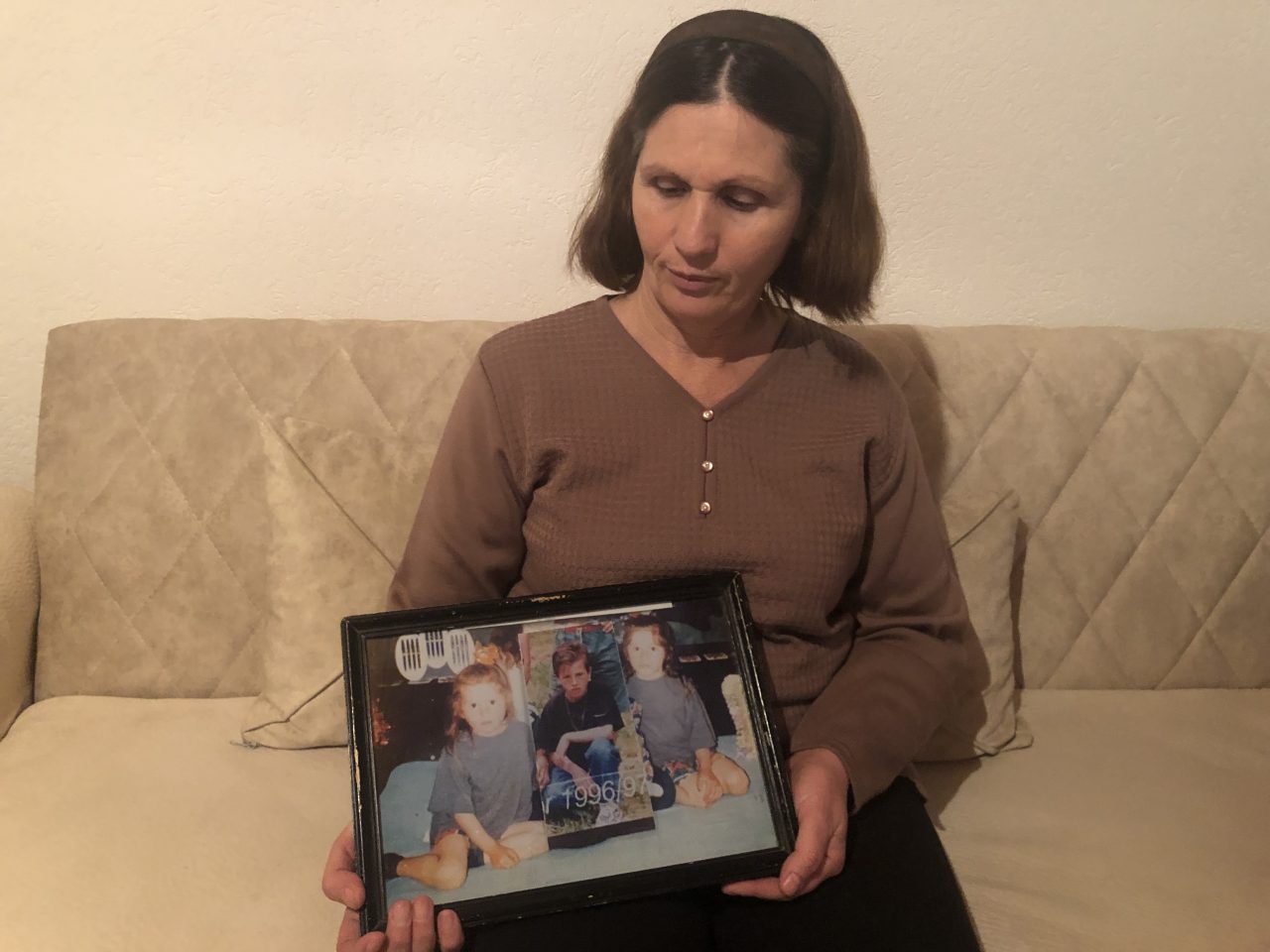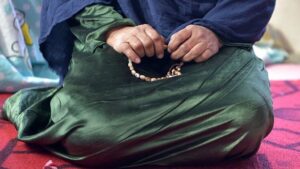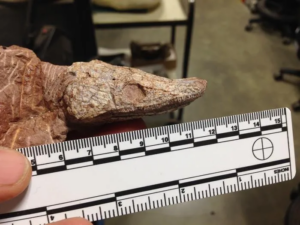Two sisters had taken refuge in the basement of an abandoned village house when it came under fire during the Kosovo war. By the time dawn broke, all eight of their children were dead.
This post is also available in this language: Shqip Bos/Hrv/Srp
Sebahate Berisha remembers the warm night of April 1, 1999 when she put all her five children to sleep wrapped up in blankets in the basement of an abandoned house in the village of Nagavc/Nogavac in Kosovo’s Rahovec/Orahovac municipality.
Like around 6,000 other ethnic Albanians from nearby villages, they had left their home to find a safer place in Nagavc/Nogavac amid attacks on nearby settlements.
A week earlier, on March 25, hours after NATO had started bombing Yugoslavia in an attempt to stop President Slobodan Milosevic’s campaign of ethnic cleansing in Kosovo. In response to the Western military campaign, Serbian forces had stepped up their attacks.
Sebahate Berisha’s sister Zyrafete Berisha, then 29, had also taken refuge in the basement of the abandoned house with her three children, along with a couple of other mothers and their children.
Since they fled their house in the nearby village of Hoce e Vogel/Velika Hoca and came to Nagavc/Nogavac, Zyrafete’s eldest son Shqipron had been sleeping upstairs in the abandoned house with his grandmother, but that night he wanted to be with his mother and sisters.
“Shqipron came down and said to me: ‘Tonight I want to sleep here, and he went to join his two sisters,” Zyrafete said. “My youngest daughter asked for some bread and I brought her a slice of bread with sugar.”
Sebahate, who was 33, woke up around one o’clock to feed her baby and change her nappies. It was hard to get her back to sleep because she hadn’t been able take her cradle with her, but they both finally fell asleep.
Zyrafete was still awake and heard their neighbour Hyrishahe saying: “I had a bad dream like they [Serbs] are shelling.” “I got up and looked out of the window and I told her to try to sleep. ‘It’s just a dream,’” Zyrafete told her.
Minutes later, Zyrafete was woken up by a huge blast and heard the walls of the house collapsing. Everyone who was sleeping in the room upstairs fell through to the lower floor as the ceiling collapsed.
It was dark, and all Zyrafete could hear were screams in the darkness. “There was no way of getting any light at that moment. I was wounded in the head, neck, hands, and leg. But I felt nothing. I was numb,” she said.
Then later someone came in from outside and lit a candle. The ceiling and the front walls had collapsed.
In the basement had been four mothers and 12 children. Almost all the children, including a three-month-old baby and its mother, were killed.
People started to gather around, trying to see who had survived under the collapsed walls. “Someone put their hand into the rubble and felt someone was moving,” Zyrafete said.
In the corner they found her sister Sebahate. She was alive but badly injured in her legs and hands and was unconscious. All her five daughters were dead.
Meanwhile Zyrafete was still trying to hear if any of her three children were alive under the rubble.
“From the moment the house was attacked until dawn, I kept going in and out of the house, trying to hear a voice or any breathing. I put my ear to the wall and the part of the broken ceiling that had fallen on them, trying to hear, to smell something, but there was nothing,” she remembered.
More than 23 years after that day, Zyrafete stares blindly into space, lost in thought, as she tries put together the memories of what she lost.
“I don’t remember much from that night. But I remember it was so dark, it seemed dawn would never break. I thought if it was light, I could see something of the children. At least once more,” she said.
A total of 42 people were killed that night between April 1 and 2, most of them children and women. Thirteen of them were from the Berisha family, including a mother and her nine-month-old daughter.
Then Serbian forces entered the village and ordered the survivors to take their tractors and trucks and head towards the Albanian border. Like hundreds of thousands of other Kosovo Albanians, they were being expelled.
‘I didn’t want to leave them’
 Sebahate Berisha with pictures of her children. Photo: Serbeze Haxhiaj/BIRN.
Sebahate Berisha with pictures of her children. Photo: Serbeze Haxhiaj/BIRN.
On the morning of April 3, lying in the main public hospital in the Albanian city of Kukes, Sebahate Berisha started to regain consciousness and thought about what had happened. All her five children – nine-year-old Adelina, seven-year-old Njomza, five-year-old Shkurtesa, two-year-old Lezie and six-month-old Elhame – were dead.
“I didn’t want to be alive anymore. But I couldn’t move,” Sebahate recalled.
Her younger sister Zyrafete also lost her three children – 12-year-old Shqipron, nine-year-old Dafina and seven-year-old Valmira. She hadn’t wanted to leave their bodies behind in the destroyed house and had to be forced to get on a tractor and go.
“I didn’t want to go and leave my children inside. It was like I was turning my back on them. I was wondering whether of them any could still be alive. I wanted to stay there and die,” she said.
Sebahate remembers how she had nightmares constantly while recovering in hospital. “I wanted to run away from the hospital. I was hearing children’s voices. They’d been left on their own,” she said.
Ten days after the attack, locals from villages near Nagavc/Nogavac and some Kosovo Liberation Army fighters managed to clear away the rubble, take the bodies and bury them in a mass grave in the yard of the house where they were killed.
“They wrapped them in sheets and put letters with their names on them in a bottle of juice between their arms. My little girl did not have a bottle between her arms. The bottle was under her left foot,” Sebahate said.
‘It was our fate’
 Zyrafete Berisha. Photo: Serbeze Haxhiaj/BIRN.
Zyrafete Berisha. Photo: Serbeze Haxhiaj/BIRN.
Sebahate and Zyrafete Berisha managed to return home with their husbands and mother-in-law on July 2, 1999, after the war had ended with NATO’s military campaign forcing a Serbian withdrawal, and found everything they owned had been had been incinerated in the fire caused by the shelling.
The only thing that had survived was baby Elhames’s cradle. “It was unbelievable how the cradle had not caught fire,” Sebahate said. “I started rocking the cradle like I was crazy. I had lost all five of my children in an instant,” she groaned. “There could be nothing worse for a mother.”
Many years later, little Elhames’s cradle was displayed in an exhibition of personal possessions, stories and photographs commemorating children killed in the Kosovo war, organised in 2019 by the Humanitarian Law Centre Kosovo in Pristina.
In 2000, Sebahate gave birth to another baby girl, and later her sister Zyrafte had a baby boy. Sebahate then gave birth to a second child, who was born with Down’s syndrome.
The injuries on Zyrafete’s head from the attack in 1999 later turned out to be worse than originally diagnosed. On August 11, 2002, when her daughter was six months old, she woke up one morning and saw her right eye was bloodshot and realised that she had lost the sight in it.
“When I went to bed I was OK, but in the morning, I couldn’t see with the right eye. The doctors told me that if I didn’t save the other eye I would be totally blind,” Zyrafete said.
For months, she tried to get a visa to go abroad for treatment but it was impossible. “There was only one option at that time. Belgrade. But I didn’t want to go to Belgrade. I said Belgrade killed my children, it destroyed me. I couldn’t go,” she said.
Ten months later, she went blind in the other eye.
The attack on Nagavc/Nogavac was one of the incidents listed in the Hague Tribunal prosecution’s indictment of high-ranking Serbian Interior Ministry official Vlastimir Djordjevic, who was convicted of war crimes and sentenced to 18 years in prison.
But others involved in the attack have not been prosecuted, and for more than two decades, no one from the Berisha family has been asked to give evidence to any investigation or testify in court.
Sebahate ultimately gave birth to more three boys. She named her daughter Adelina after her eldest daughter who was killed in 1999. Zyrafete also named her son and daughter Shqipron and Valmira after her two children who were killed.
These days, Sebahate lives next door to her blind sister Zyrafete, and has helped her to raise her children.
But she said she has never wanted to talk about her life or how she coped with her trauma. “We did what we could, in the way that we could. It was our fate,” she explained.
“But the war is inside me, and it will never end.”




